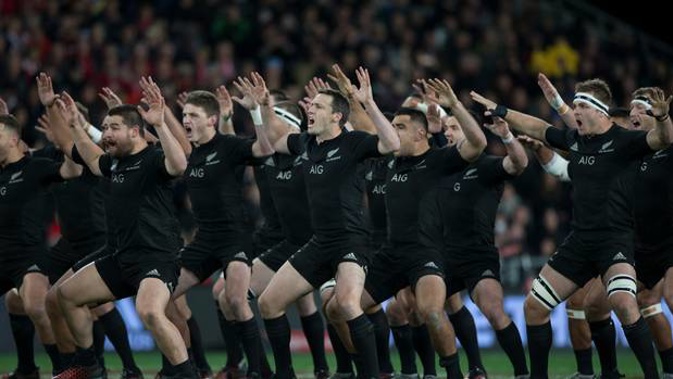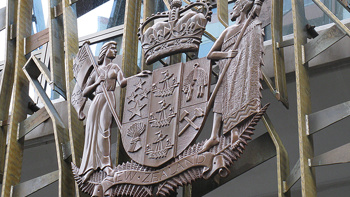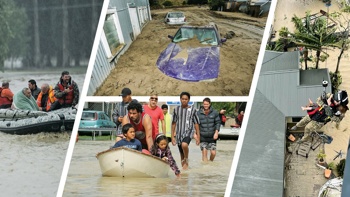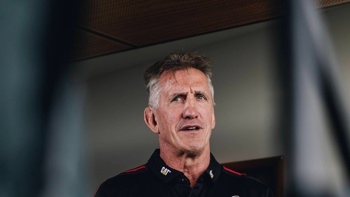
A new book from respected British journalist Peter Bills - The Jersey - is set to reignite discussion over the role the haka plays for the All Blacks. In this abridged extract from The Haka: An Expression of Identity chapter, ex-All Blacks Sir Colin Meads and Kees Meeuws reveal their own frustrations about the heavy use of the haka. And the team's mental skills coach, Gilbert Enoka, has revealed the All Blacks had previously felt "haka‑ed out" and some "hated" having to constantly perform the Ka Mate version.
The Ka Mate haka is almost 140 years old, first composed by Te Rauparaha, Ngāti Toa Rangatira. The other haka are even older than Ka Mate, but it's doubtful it has ever been so widely talked about or debated. Is it fair?
Shouldn't the opposition get to perform their own dance after the haka? It excites opinions almost like nothing else in New Zealand and world rugby circles.
Former All Blacks first five‑ eighth Andrew Mehrtens has called it "too commercialised".
Ex‑England half‑back Matt Dawson reckons it has lost its mystique.
Another former All Black, prop forward Kees Meeuws, says, "It has lost its mana. It has become a showpiece. They should do it at certain test matches but not all.
"It was good a few years ago when they had a choice. But now they play 14 test matches a year and that's too much as far as the haka is concerned. We should either have it at home or just away from home, like it used to be. Not both."
/arc-anglerfish-syd-prod-nzme.s3.amazonaws.com/public/JBJQYFMRSFEIHHVZ7LG7OGHOQM.jpg)
All Blacks performing a haka before playing England at Twickenham in 1925. (Photo / Supplied)
A strange phenomenon, this. It affects all sorts of people in a variety of ways. Some are enraged, some supportive, some intrigued, some ambivalent.
Former Wallaby captain John Eales turned his back on it once and has regretted doing so ever since.
Whatever its form and whatever the occasion, there is no doubt the haka raises hackles.
Take Willie Anderson, bastion of Northern Ireland men, proud Ireland international rugby man, possessor of a bone‑crushing handshake and focus of a few memorable moments in Irish rugby history.
At Lansdowne Road, Dublin in 1989 against New Zealand, Ireland captain Anderson lined up his men on the halfway line to face the haka. They linked arms and were dragged ever closer to the dancing, gesticulating New Zealanders by Anderson, until they were almost in the All Blacks' faces.
/arc-anglerfish-syd-prod-nzme.s3.amazonaws.com/public/77OSR6E46FBCZCT25P4BSR7SDA.jpg)
The haka performed by the Maori team in 1950. (Photo / Supplied)
But it didn't come close to un‑settling the All Blacks when the game started. They won 23–6.
In 2008, the Welsh let the haka pass and then mucked about for a few minutes, refusing to line up for the kick‑off. They presumably wanted to let the New Zealanders' adrenaline drain away.
It must have worked . . . to a degree. Wales had lost their two previous encounters with the All Blacks 3–41 and 10–45. So their 9–29 defeat this time was an improvement. Perhaps . . .
A few months before he died in 2017, Sir Colin Meads said of it, "We never did the haka in New Zealand, only overseas.
"But they put so much emphasis on the haka nowadays. They have two or three different versions. They even practise it.
"Our hakas were pretty rough. Mind you, you would be fined at the players' court session if you jumped out of sync with the others. But it has now become too big.
"They haka everything now. Some dignitary or sports person turns up or a film star at the airport and they haka them. It is ridiculous. I think it has become a celebrity thing. All the schools practise it.
"It should be done before games but as a form of respect to the Maori. We were haka‑ed out there for a while and still are."
John Eales is as respected a former player as any exists in world rugby. However, there was a time when most of New Zealand would cheerfully have strung him up from the nearest lamp post for dishonouring the haka.
Eales understands he got it wrong.
"It was my first test as captain and we didn't face the haka. I'd think that was disgraceful now. But I didn't understand it then. I suppose we were trying to detract from its power. But we ended up dissipating our own skills. We lost that match in Wellington 43–6. That is still the biggest losing margin ever by a Wallaby team against anyone. I always felt bad about what happened before that Test."
But does it give the All Blacks an advantage? Eales believes it gives them a way to connect as a team. "And any team that connects is a dangerous outfit."
Eales felt so mortified by that experience, that it festered. Years later, in 2017, he flew to Auckland with a film crew to make a television programme about his experience. He wanted to explore the ways and means of the haka. It was something of a cathartic exercise. He did it, he now says, because he was looking for an insight into it.
/arc-anglerfish-syd-prod-nzme.s3.amazonaws.com/public/HYU7AZDJ6JCQ5KOJFCFMM3OBCA.jpg)
Sid Going leading an All Black haka before playing the Barbarians - the only pre-match haka performed on the tour of the United Kingdom in 1972. (Photo / Supplied)
But as he began to do interviews and make the film, he came to realise that the real power of it lay not so much in the dance but in the way it connects with individuals and with the team. Perhaps also with the broader population of rugby for it is about their land.
"The Ka Mate haka talks of a warrior hiding from his enemies: 'I am going to die, I am going to live'. I reckon that is so powerful because there is this guy having a battle with himself about life. He is going through this internal conflict. He is hiding.
"It is a tale of survival against the odds. So when they do this they are connecting with their people, it is the battle that is coming. But this is an internal battle."
The former All Black prop Craig Dowd participated in the film John Eales made, together with Wayne Shelford and Frank Bunce.
In a general discussion on the pitch at Eden Park, Auckland, he revealed that one opposition team had messed about after the haka had been done, the challenge set. The All Blacks had found themselves on edge, said Dowd.
They were ready for war, but the opposition weren't. They were slow in removing their tracksuits; the All Blacks were ready and in their playing outfit. First, a trainer had to come onto the pitch to collect all their opponents' tracksuits. Then the opposition gathered in a huddle for last minute messages, which seemed to go on and on.
Then, very slowly, they made their way to their starting positions.
"By this time," said Dowd, "we'd lost the momentum. We knocked on the kick‑off, dropped a couple of passes and were all over the place for a while."
The antidote to the passion? Perhaps.
/arc-anglerfish-syd-prod-nzme.s3.amazonaws.com/public/GNCL73DGZND23ATBTEGA6OQUWM.jpg)
All Blacks haka before the Munster game in 1978. (Photo / Getty)
Irishman Tony Ward, for one, is convinced the haka is a valuable psychological weapon. "There is no doubt it gives them an advantage. By a million per cent. The haka stirs them up, gives them motivation at the expense of the opposition.
"The All Blacks have an advantage because they are physically active while they are doing it. In effect, they are warming up by doing it."
Maybe two or three minutes should be allowed for the opposition to warm up similarly, once the haka is completed, Ward suggests.
But what is its role in the context of the modern game?
Essentially, you feel that two questions arise.
Should world rugby continue to smile and tolerate it as a quirk of the old game? Particularly if, as some suggest, it is a clear advantage, an obvious motivational tool for the New Zealanders. That is a matter of opinion.
But one team's view is as worthy as the other's.
Secondly, and this is perhaps in a far broader sense, does New Zealand need to continue doing it on every single occasion? Is it not a special, unique part of New Zealand culture? Shouldn't it be respected as such, reserved perhaps for visiting heads of state, royalty or a major rugby occasion, such as a World Cup final? But just any old rugby match? With all due respect, is that not downgrading the whole thing? And does it not risk diminishing its exclusivity?
Does New Zealand need to do it any longer? Is the haka now a brand as well as an identity? And besides, is an expression of identity something this country still needs in 2018?
/arc-anglerfish-syd-prod-nzme.s3.amazonaws.com/public/2BMJWVFAH5CKPABTKULBVWTQ2A.jpg)
Richie McCaw and Luke Romano of the All Blacks perform the Haka in 2013. (Photo / Getty)
An argument may once have been made for it, along the lines of it representing a little country fighting above its weight against world opponents. Some may have seen it as the personification of a country that still needed the emotional and cultural crutch it brought.
But surely that is not the case nowadays?
Gilbert Enoka admits New Zealand rugby men themselves had reached something of a crossroads over the haka.
"There were a lot of guys saying they felt we were haka‑ed out. They said, 'We do the haka all the time, we have TV cameras in our faces'. They hated it. They said, 'All I want to do is get the damn thing done and over with'.
"They said, 'It's not for us anyway. It's just for the Maori people'. So we had a real crisis of identity where we had to sit down and say, 'Who are we as New Zealanders, who are we as All Blacks?' That was really where Kapa O Pango was born."
Kapa O Pango, a new haka created by Derek Lardelli of Ngāti Porou, took a year to choreograph. First performed before a 2005 Tri‑Nations international against South Africa in Dunedin, the words used were considered more specific to the rugby team than Ka Mate.
They refer to the warriors in black and the silver fern. For most of the New Zealand players, it was a more appropriate haka than Ka Mate.
Undeniably, the haka is a wonderful sporting tradition. But it is also a valuable motivational tool that gives New Zealand an advantage, whatever the percentage.
And then there is the issue of overkill, a danger to which the late Sir Colin Meads referred. A World Cup final? Clearly. But in all three test matches of one nation's tour to New Zealand?
Surely, before the first test of the series would be enough. Then the challenge is set.
The Jersey by Peter Bills, Macmillan, RRP $44.99, publishing on 14 August.
Take your Radio, Podcasts and Music with you









